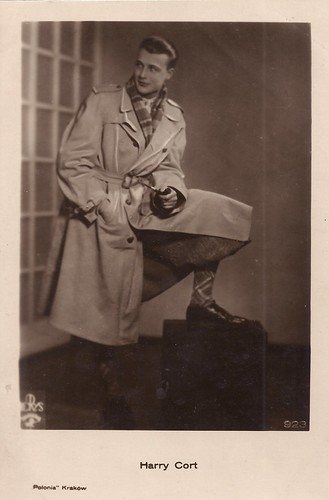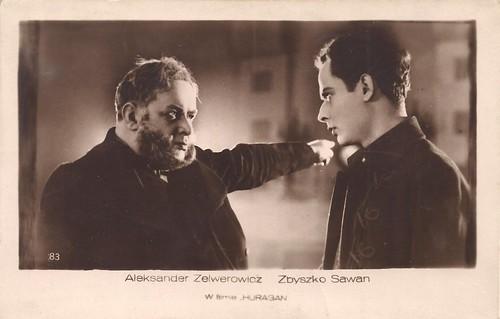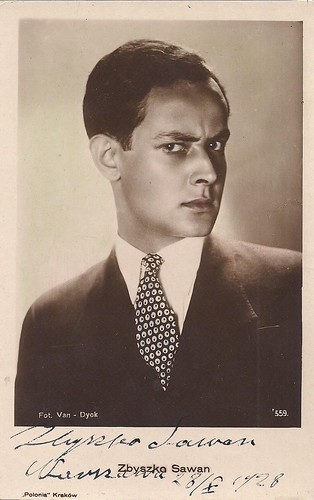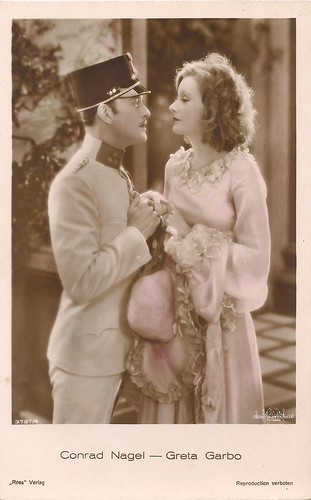Last week, Joanna from Warsaw sent me a series of scans of vintage postcards from Poland. These included three cards with film star Zbyszko Sawan, who was a popular heartthrob in Poland during the late 1920s and early 1930s. There was also one of the famous stage actor and director Aleksander Zelwerowicz in a silent film with Sawan, and one of a Harry Cort, a mysterious prince from an old dynasty whose film career was cut short after a 'social scandal'. But besides the Polish cards, the collection of Joanna also contains beautiful Ross and Iris Verlag postcards of international stars of the late 1920s.
![Lily Damita]()
Lily Damita. Austrian postcard by Iris Verlag, no. 763. Photo: Manassé, Wien / Sascha. Collection: Joanna.
![Lya de Putti]()
Lya de Putti. German postcard by Ross Verlag, no. 3370/2, 1928-1929. Photo: (Roman) Freulich. Collection: Joanna.
Joanna wrote me: "Some time ago my parents had been liquidated the house of my grandfather's brother. He was already widowed and had no children. Among other stuff there were several old postcards and photos.
I think his wife was born and lived in Krakow or Lwow before marriage and I guess the film star postcards belonged to her. I doubt whether my uncle would collect autographs of film stars..."
I asked Joanna which postcard her favourite is. Joanna: "I think I admire the card with... Vilma Banky. It is very nice and unique. She is here like a ballet dancer not like an actress."
![Willy Fritsch]()
Willy Fritsch. German postcard by Ross Verlag, no. 3288/4, 1928-1929. Photo: Ufa. Collection: Joanna.
![Harry Cort]()
Harry Cort. Polish postcard by Polonia, Krakow, no. 923.Collection: Joanna.
Polish actor Harry Cort (1905-?) came from a royal dynasty. Cort was born Prince Stanisław Józef Gedyminowicz-Bielski in Trzeszczany near Zamosc, Russia (now Poland). Staś was born in the lineage of the Gediminids dynasty of monarchs in the Grand Duchy of Lithuania, that reigned from the 14th to the 16th century.
As Harry Cort, he had a short film career with starring roles in three silent films. His film debut was the adventure film 9:25. Przygoda jednej nocy/ 9:25. Adventure one night (Adam Augustynowicz, Ryszard Biske, 1929) in which he co-starred with Iza Norska. The film is now considered lost.
The following year he played the male lead in the drama Halka (Konstanty Meglicki, 1930). Halka was played by Zorika Szymanska. Cort’s third and final film was the romantic comedy Karuzela zycia/Carousel of life (Boleslaw Micinski, 1930) in which he co-starred again with Iza Norska. This film also seems to be lost.
With the advent of the era of sound films Harry Cort began an intensive study to learn singing and diction. In the early days of the sound era, films were recorded in various languages. Cort prepared to play in films spoken in Polish, German and French.
With his knowledge of languages and contacts with Polish-born Hollywood star Pola Negri, he wanted to play in foreign films. By the late 1930s he was involved in a ‘social scandal’ that shattered his plans for acting, according to the Polish website Nitrofilm.
Probably he then went abroad. The fate of Harry Cort or Prince Gedyminowicz-Bielski is unknown.
![Vilma Banky]()
Vilma Banky. German postcard by Ross Verlag, no. 3482/2, 1928-1929. Photo: United Artists. Collection: Joanna.
![Zbyszko Sawan and Aleksander Zelwerowicz in Huragan (1928)]()
Polish postcard, no. 83. Photo: publicity still for Huragan/Hurricane (Joseph Lejtes, 1928) with Zbigniew or Zbyszko Sawan and Aleksander Zelwerowicz. Collection: Joanna.
Polish actor Zbigniew Sawan (1904–1984) starred both in silent and sound film, and was also a respected stage actor in his country. He also worked as a theatre director and manager.
Aleksander Zelwerowicz (1877-1955) was a Polish actor, director, theatre president and a teacher. He received the Order of Polonia Restituta, one of Poland's highest Orders. He is also one of the Polish Righteous among the Nations, recognized by Yad Vashem as non-Jews who saved Jews from extermination during the Holocaust.
Joanna: "Zbyszko Sawan was popular, but I think that nowadays only people from the cinema branch know his name. When you ask contemporary Pole about him - no ne will reply I think... Zelwerowicz is a well known name but mostly because he is a patron of one of the best theatre schools in Poland."
During World War II, Zelwerowicz was active for the Konrad Żegota Committee. This was a codename for the Council to Aid Jews (Polish: Rada Pomocy Żydom), an underground organization of Polish resistance in German-occupied Poland active from 1942 to 1945.
It is estimated that about half of the Jews who survived the Holocaust in Poland (thus over 50,000) were aided in some shape or form by Żegota.
In 1955, Aleksander Zelwerowicz died in Warsaw. He was 77. Since 1996, the Aleksander Zelwerowicz State Theatre Academy, the National Higher School of Theatre in Warsaw, is named after him.
![Untitled]()
Marja Malicka and Zbyszko Sawan in Dzikuska (1928). Polish postcard by Edition Victoria. Photo: Lux. Publicity still for Dzikuska/Savage (Henryk Szaro, 1928). Collection: Joanna.
![Zbyszko Sawan]()
Zbyszko Sawan. Polish postcard by Polonia, Krakow, no. 559. Photo: Van Dyck. Signature from 1928. Collection: Joanna.
Joanna wrote me a funny little story about how she discovered old film star postcards.
"Once, many years ago I received a card from my favourite uncle by mail - it was an old postcard with Zbyszko Sawan's photo. My uncle had written several sentences for me on that 50-years old card and sent it by post!
I was so surprised and it was funny that he sent such an old 'film amant' photo to a girl like me.
Anyway, I can not find that one. But recently, when I was looking for something completely different among my father's old photos and letters I found my uncle's old postcards.
I wanted to share them. When I googled 'old postcards + cinema + film stars', your www page was most interesting to me. So I sent the postcards to you :)."
And we're so glad you did... Dzięki, Joanna!
![Liane Haid]()
Liane Haid. German postcard by Ross Verlag, no. 1825/2, 1927-1928. Photo: Atelier Balázs, Berlin. Collection: Joanna.
![Greta Garbo and Conrad Nagel in The Mystrerious Lady (1928)]()
Greta Garbo and Conrad Nagel in The Mysterious Lady (1928). German postcard by Ross Verlag, no. 3787/4, 1928-1929. Photo: Metro-Goldwyn-Mayer. Publicity still for The Mysterious Lady (Fred Niblo, 1928). Collection: Joanna.
Sources: Nitrofilm (Polish), Queer (Polish), Film Polski (Polish), Filmweb (Polish), Wikipedia (English and Polish), and IMDb.

Lily Damita. Austrian postcard by Iris Verlag, no. 763. Photo: Manassé, Wien / Sascha. Collection: Joanna.

Lya de Putti. German postcard by Ross Verlag, no. 3370/2, 1928-1929. Photo: (Roman) Freulich. Collection: Joanna.
Autographs
Joanna wrote me: "Some time ago my parents had been liquidated the house of my grandfather's brother. He was already widowed and had no children. Among other stuff there were several old postcards and photos.
I think his wife was born and lived in Krakow or Lwow before marriage and I guess the film star postcards belonged to her. I doubt whether my uncle would collect autographs of film stars..."
I asked Joanna which postcard her favourite is. Joanna: "I think I admire the card with... Vilma Banky. It is very nice and unique. She is here like a ballet dancer not like an actress."

Willy Fritsch. German postcard by Ross Verlag, no. 3288/4, 1928-1929. Photo: Ufa. Collection: Joanna.

Harry Cort. Polish postcard by Polonia, Krakow, no. 923.Collection: Joanna.
Social Scandal
Polish actor Harry Cort (1905-?) came from a royal dynasty. Cort was born Prince Stanisław Józef Gedyminowicz-Bielski in Trzeszczany near Zamosc, Russia (now Poland). Staś was born in the lineage of the Gediminids dynasty of monarchs in the Grand Duchy of Lithuania, that reigned from the 14th to the 16th century.
As Harry Cort, he had a short film career with starring roles in three silent films. His film debut was the adventure film 9:25. Przygoda jednej nocy/ 9:25. Adventure one night (Adam Augustynowicz, Ryszard Biske, 1929) in which he co-starred with Iza Norska. The film is now considered lost.
The following year he played the male lead in the drama Halka (Konstanty Meglicki, 1930). Halka was played by Zorika Szymanska. Cort’s third and final film was the romantic comedy Karuzela zycia/Carousel of life (Boleslaw Micinski, 1930) in which he co-starred again with Iza Norska. This film also seems to be lost.
With the advent of the era of sound films Harry Cort began an intensive study to learn singing and diction. In the early days of the sound era, films were recorded in various languages. Cort prepared to play in films spoken in Polish, German and French.
With his knowledge of languages and contacts with Polish-born Hollywood star Pola Negri, he wanted to play in foreign films. By the late 1930s he was involved in a ‘social scandal’ that shattered his plans for acting, according to the Polish website Nitrofilm.
Probably he then went abroad. The fate of Harry Cort or Prince Gedyminowicz-Bielski is unknown.

Vilma Banky. German postcard by Ross Verlag, no. 3482/2, 1928-1929. Photo: United Artists. Collection: Joanna.

Polish postcard, no. 83. Photo: publicity still for Huragan/Hurricane (Joseph Lejtes, 1928) with Zbigniew or Zbyszko Sawan and Aleksander Zelwerowicz. Collection: Joanna.
One of the Polish Righteous among the Nations
Polish actor Zbigniew Sawan (1904–1984) starred both in silent and sound film, and was also a respected stage actor in his country. He also worked as a theatre director and manager.
Aleksander Zelwerowicz (1877-1955) was a Polish actor, director, theatre president and a teacher. He received the Order of Polonia Restituta, one of Poland's highest Orders. He is also one of the Polish Righteous among the Nations, recognized by Yad Vashem as non-Jews who saved Jews from extermination during the Holocaust.
Joanna: "Zbyszko Sawan was popular, but I think that nowadays only people from the cinema branch know his name. When you ask contemporary Pole about him - no ne will reply I think... Zelwerowicz is a well known name but mostly because he is a patron of one of the best theatre schools in Poland."
During World War II, Zelwerowicz was active for the Konrad Żegota Committee. This was a codename for the Council to Aid Jews (Polish: Rada Pomocy Żydom), an underground organization of Polish resistance in German-occupied Poland active from 1942 to 1945.
It is estimated that about half of the Jews who survived the Holocaust in Poland (thus over 50,000) were aided in some shape or form by Żegota.
In 1955, Aleksander Zelwerowicz died in Warsaw. He was 77. Since 1996, the Aleksander Zelwerowicz State Theatre Academy, the National Higher School of Theatre in Warsaw, is named after him.

Marja Malicka and Zbyszko Sawan in Dzikuska (1928). Polish postcard by Edition Victoria. Photo: Lux. Publicity still for Dzikuska/Savage (Henryk Szaro, 1928). Collection: Joanna.

Zbyszko Sawan. Polish postcard by Polonia, Krakow, no. 559. Photo: Van Dyck. Signature from 1928. Collection: Joanna.
Film Amant
Joanna wrote me a funny little story about how she discovered old film star postcards.
"Once, many years ago I received a card from my favourite uncle by mail - it was an old postcard with Zbyszko Sawan's photo. My uncle had written several sentences for me on that 50-years old card and sent it by post!
I was so surprised and it was funny that he sent such an old 'film amant' photo to a girl like me.
Anyway, I can not find that one. But recently, when I was looking for something completely different among my father's old photos and letters I found my uncle's old postcards.
I wanted to share them. When I googled 'old postcards + cinema + film stars', your www page was most interesting to me. So I sent the postcards to you :)."
And we're so glad you did... Dzięki, Joanna!

Liane Haid. German postcard by Ross Verlag, no. 1825/2, 1927-1928. Photo: Atelier Balázs, Berlin. Collection: Joanna.

Greta Garbo and Conrad Nagel in The Mysterious Lady (1928). German postcard by Ross Verlag, no. 3787/4, 1928-1929. Photo: Metro-Goldwyn-Mayer. Publicity still for The Mysterious Lady (Fred Niblo, 1928). Collection: Joanna.
Sources: Nitrofilm (Polish), Queer (Polish), Film Polski (Polish), Filmweb (Polish), Wikipedia (English and Polish), and IMDb.